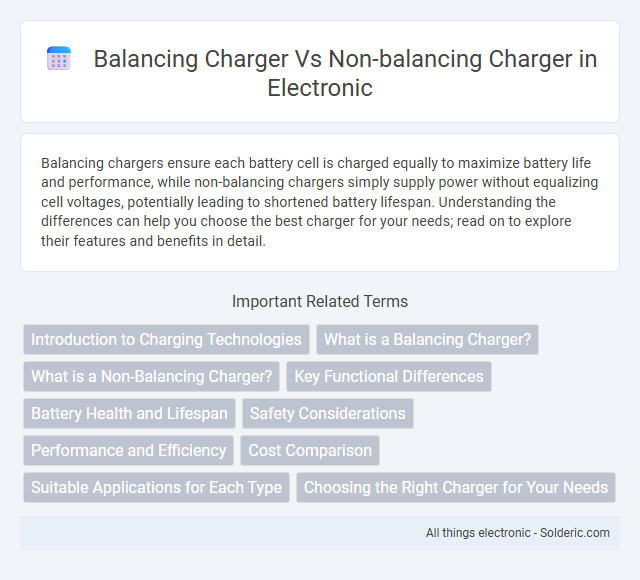Balancing chargers ensure each battery cell is charged equally to maximize battery life and performance, while non-balancing chargers simply supply power without equalizing cell voltages, potentially leading to shortened battery lifespan. Understanding the differences can help you choose the best charger for your needs; read on to explore their features and benefits in detail.
Comparison Table
| Feature | Balancing Charger | Non-Balancing Charger |
|---|---|---|
| Function | Charges each battery cell individually to ensure equal voltage levels. | Charges the battery pack as a whole without individual cell monitoring. |
| Battery Health | Prolongs battery lifespan by preventing cell overcharge and imbalance. | May cause uneven cell aging and reduce overall battery life. |
| Safety | Reduces risk of overheating, swelling, and potential fire hazards. | Higher risk of overheating and battery damage due to imbalance. |
| Use Case | Ideal for multi-cell lithium polymer (LiPo) and lithium-ion batteries. | Suitable for single-cell batteries or less sensitive applications. |
| Cost | Generally more expensive due to advanced circuitry. | Lower cost, simpler design. |
| Charging Speed | Moderate charging speed with controlled balancing process. | Potentially faster charging but at the expense of cell health. |
Introduction to Charging Technologies
Balancing chargers regulate the voltage and current delivered to each individual cell within a multi-cell battery pack, ensuring uniform charge and preventing cell damage or capacity loss. Non-balancing chargers treat the battery pack as a single unit, which can lead to uneven cell voltage levels, reducing overall battery lifespan and safety. Modern charging technologies prioritize balancing chargers for lithium-ion and lithium-polymer batteries to enhance performance, durability, and safety during the charging process.
What is a Balancing Charger?
A balancing charger ensures each cell in a multi-cell battery pack charges evenly by monitoring and adjusting the voltage of individual cells, preventing overcharging and extending battery lifespan. Unlike non-balancing chargers, which apply a uniform charge to the entire pack, balancing chargers optimize performance and safety by maintaining cell voltage equilibrium. You achieve better battery health and reliability by using a balancing charger for lithium polymer (LiPo) or lithium-ion (Li-ion) batteries.
What is a Non-Balancing Charger?
A non-balancing charger charges each battery cell without monitoring or equalizing their individual voltages, which can lead to uneven cell performance and potential safety risks over time. Unlike balancing chargers, non-balancing chargers simply supply a constant voltage or current to the entire battery pack, making them less suitable for multi-cell lithium-ion or LiPo batteries. Choosing the right charger affects your battery's longevity and safety, especially if you handle high-capacity or multi-cell battery packs.
Key Functional Differences
Balancing chargers actively monitor and equalize the voltage of each individual cell within a battery pack, ensuring optimal performance and prolonged battery life. Non-balancing chargers simply charge the entire battery pack as a whole without adjusting individual cell voltages, which can lead to cell imbalance and reduced battery efficiency over time. Understanding these key functional differences helps you select the right charger type for safer, more reliable battery maintenance.
Battery Health and Lifespan
Balancing chargers ensure each battery cell is charged evenly, preventing overcharging and minimizing cell voltage imbalances, which significantly improves battery health and extends overall lifespan. Non-balancing chargers can lead to uneven charge distribution, causing some cells to degrade faster and reducing the battery's usable life. Proper cell balancing is essential for maintaining capacity, safety, and long-term performance of multi-cell lithium batteries.
Safety Considerations
Balancing chargers enhance safety by ensuring each cell in a battery pack is charged evenly, preventing overcharging and reducing the risk of overheating or fire. Non-balancing chargers can cause cell imbalance, leading to premature battery degradation and potential safety hazards. Your choice of charger significantly impacts the longevity and safety of multi-cell battery systems.
Performance and Efficiency
Balancing chargers ensure each battery cell is charged uniformly, preventing overcharging and extending battery lifespan, which enhances overall performance and efficiency. Non-balancing chargers may lead to uneven cell voltages, reducing battery capacity and increasing the risk of damage or failure. Choosing a balancing charger helps maintain optimal battery health, ensuring reliable and efficient power delivery for your devices.
Cost Comparison
Balancing chargers typically cost more than non-balancing chargers due to their advanced circuitry designed to monitor and equalize individual cell voltages, ensuring enhanced battery lifespan and safety. Non-balancing chargers, being simpler and less sophisticated, are significantly cheaper but risk overcharging or undercharging cells, potentially leading to reduced battery efficiency and lifespan. Investing in a balancing charger often results in long-term savings by preventing battery damage and reducing replacement frequency.
Suitable Applications for Each Type
Balancing chargers are ideal for lithium-ion and lithium-polymer batteries used in drones, RC vehicles, and high-performance electronics, ensuring each cell is charged evenly to prevent overcharging and enhance battery lifespan. Non-balancing chargers suit simpler applications with single-cell batteries or lead-acid batteries, such as flashlights and basic power tools, where balanced cell management is not critical. Selecting the correct charger type depends on battery chemistry and the requirement for cell-level safety and performance optimization.
Choosing the Right Charger for Your Needs
Balancing chargers ensure each cell in a multi-cell battery is charged equally, preventing overcharging and extending battery life, making them ideal for complex battery packs like LiPo or Li-ion batteries. Non-balancing chargers, on the other hand, charge the entire battery pack as a whole, which may be faster but risks uneven cell voltage and potential damage. Choosing your charger depends on the battery type and safety requirements, with balancing chargers recommended for maintaining battery health and performance in sophisticated battery systems.
balancing charger vs non-balancing charger Infographic

 solderic.com
solderic.com